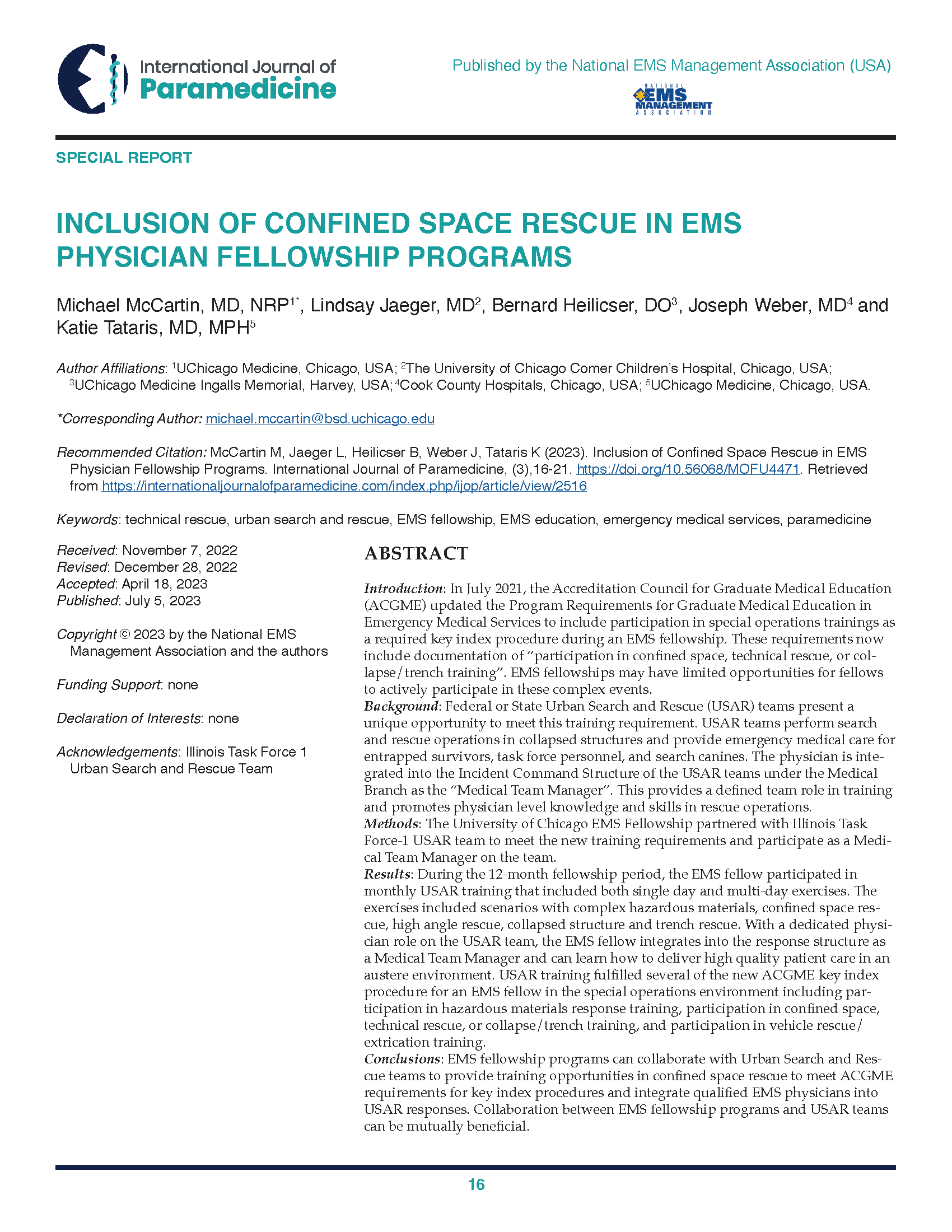Inclusion of Confined Space Rescue in EMS Physician Fellowship Programs
Main Article Content
Abstract
Introduction: In July 2021, the ACGME updated the Program Requirements for Graduate Medical Education in Emergency Medical Services to include participation in special operations trainings as a required key index procedure during an EMS fellowship. These requirements now include documentation of “participation in confined space, technical rescue, or collapse/trench training”. EMS fellowships may have limited opportunities for fellows to actively participate in these complex events.
Background: Federal or State Urban Search and Rescue (USAR) teams present a unique opportunity to meet this training requirement. USAR teams perform search and rescue operations in collapsed structures and provide emergency medical care for entrapped survivors, task force personnel, and search canines. The physician is integrated into the Incident Command Structure of the USAR teams under the Medical Branch as the “Medical Team Manager”. This provides a defined team role in training and promotes physician level knowledge and skills in rescue operations.
Methods: The University of Chicago EMS Fellowship partnered with Illinois Task Force-1 USAR team to meet the new training requirements and participate as a Medical Team Manager on the team.
Results: During the 12-month fellowship period, the EMS fellow participated in monthly USAR training that included both single day and multi-day exercises. The exercises included scenarios with complex hazardous materials, confined space rescue, high angle rescue, collapsed structure and trench rescue. With a dedicated physician role on the USAR team, the EMS fellow integrates into the response structure as a Medical Team Manager and can learn how to deliver high quality patient care in an austere environment. USAR training fulfilled several of the new ACGME key index procedure for an EMS fellow in the special operations environment including participation in hazardous materials response training, participation in confined space, technical rescue, or collapse/trench training, and participation in vehicle rescue/extrication training.
Conclusions: EMS fellowship programs can collaborate with Urban Search and Rescue teams to provide training opportunities in confined space rescue to meet ACGME requirements for key index procedures and integrate qualified EMS physicians into USAR responses. Collaboration between EMS fellowship programs and USAR teams can be mutually beneficial.
Article Details

This work is licensed under a Creative Commons Attribution-ShareAlike 4.0 International License.
Publishing in IJOP allows authors to keep their copyright while giving IJOP unrestricted copyright permissions. Articles published in IJOP use Creative Common Attribution 4.0 International (CC BY-ND 4.0) licensing. This license requires that re-users give credit to the creator. It allows re-users to copy and distribute the material in any medium or format in unadapted form only, even for commercial purposes. Additional terms apply and can be accessed here.
Publishing in IJOP also allows authors to have contracts for non-exclusive distribution of the Journal's published version of the article, such as posting to an institutional repository or publication in a book, on the condition that the original publication in the original layout format in IJOP is retained and acknowledged.
We permit and encourage authors to post the articles they published in IJOP on their affiliated websites. This helps share the information, encourages citation in other works, and promotes scholarly discourse in the spirit of open access.
References
Accreditation Council for Graduate Medical Education (2021). ACGME Program Requirements for Graduate Medical Education in Emergency Medical Services. https://www.acgme.org/globalassets/pfassets/programrequirements/112_emergencymedicalservices_2022.pdf
Federal Emergency Management Agency (USA) (2003). Field Operations Guide. https://www.fema.gov/pdf/emergency/usr/usr_fog_sept_25_2003_color_final.pdf
Federal Emergency Management Agency (USA). (2020, September 8). Resource Typing: Urban Search and Rescue. https://rtlt.preptoolkit.fema.gov/Public/Resource/View/8-508-1262?q=urban%20search%20and%20rescue
Federal Emergency Management Agency (USA). (2020, November 4). Urban Search and Rescue. https://www.fema.gov/emergency-managers/national-preparedness/frameworks/urban-search-rescue
Federal Emergency Management Agency (USA). (2022, January 26). Task Force Locations. https://www.fema.gov/emergency-managers/national-preparedness/frameworks/urban-search-rescue/task-force-locations
Macintyre, A. G., Barbera, J. A., & Smith, E. R. (2006). Surviving Collapsed Structure Entrapment after Earthquakes: A “Time-to-Rescue” Analysis. Prehospital and Disaster Medicine, 21(01), 4–17. https://doi.org/10.1017/S1049023X00003253

